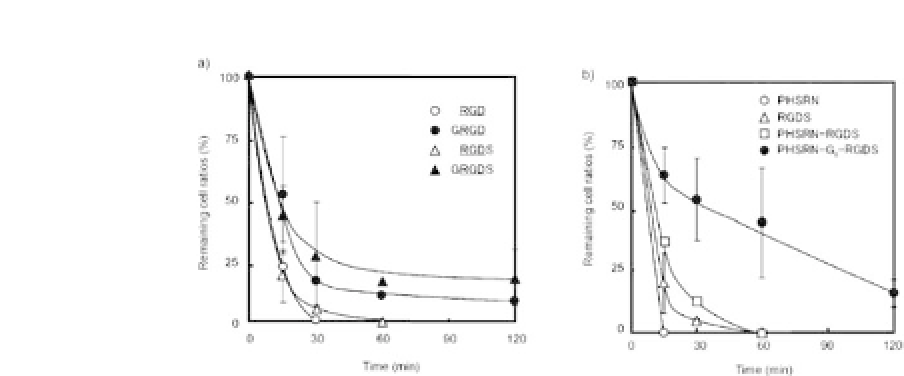Biomedical Engineering Reference
In-Depth Information
Figure 44.5.
Detachment profiles for HUVECs seeded on the follow-
ing peptide-immobilized poly(IPAAm-co-CIPAAm)-grafted surfaces as a
function of time: (a) RGD, GRGD, RGDS, and GRGDS. (b) PHSRN, RGDS,
PHSRN-RGDS, and PHSRN-G6-RGDS. The cells have been incubated at
37
◦
C for 24 h in the absence of FBS and have been transferred to an
incubator equipped with a cooling unit fixed at 20
◦
C. The results are
reported as the percentage of cells remaining on the surfaces.
Abbrevia-
tions
: FBS, fetal bovine serum; GRGD, glycine-arginine-glycin-aspartic aci;
GRGDS, glycine-arginine-glycin-aspartic aci-serine. Reprinted with per-
mission from Ref. 41. Copyright 2008 John Wiley & Sons, Inc.
veryimportantforcellfunctionregulationbecausecellsurfaceinte-
grins not only bind to cell adhesive ligands in ECM but also serve to
produce subsequent cell signal transduction activity. Moreover, this
approachfacilitatesaserum-freecellcultureforthesafetyofclinical
applications using cultured cells and noninvasive cell recovery (no
enzymes)thathelpmaintainoriginalcellfunction,bothofwhichare
important to applications in tissueengineering.
44.4 Applications of Cell Sheet Technology
Cell sheet technology with a temperature-responsive culture dish
allowsfornoninvasiveharvestingofculturedcellsasanintactmono-
layer cell sheet, including deposited ECM.
12
Using cell sheet engi-
neering, we can completely avoid scaffolds, fixation, or sutures for
conventionaltissueengineeringapproachesusingisolatedcellinjec-
tions and scaffold-based technologies, whose applicability is often
limited.Directtransplantationshavebeenappliedtocornealepithe-
lia, mucosal epithelia, periodontal ligament cells, bladder epithelia,








Search WWH ::

Custom Search